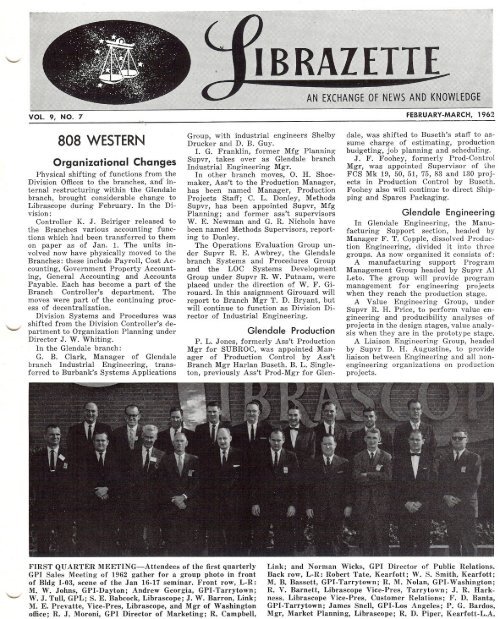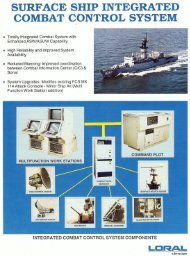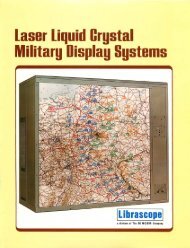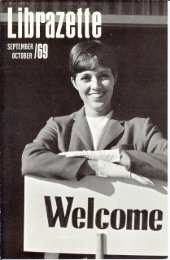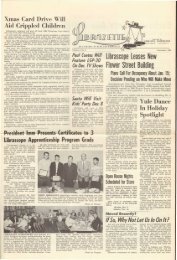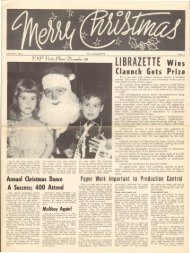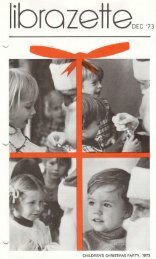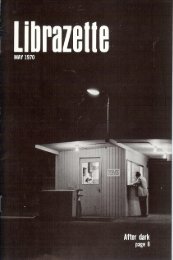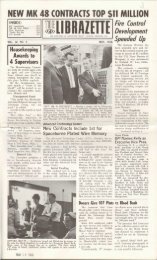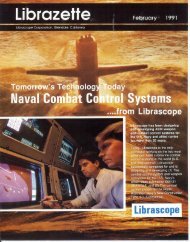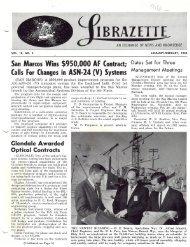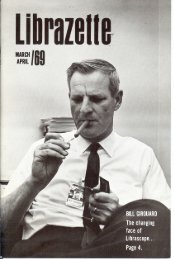February, 1962 Librazette - Librascope Memories
February, 1962 Librazette - Librascope Memories
February, 1962 Librazette - Librascope Memories
You also want an ePaper? Increase the reach of your titles
YUMPU automatically turns print PDFs into web optimized ePapers that Google loves.
VOL. 9, NO.7<br />
808 WESTERN<br />
Organizational Changes<br />
Phvsical shifting of functions from the<br />
Division Offices to the branches, and' internal<br />
restructuring within the Glendale<br />
branch, brought considerable change to<br />
<strong>Librascope</strong> during <strong>February</strong>. In the Division:<br />
Controller K. J. Beiriger released to<br />
the Branches various accounting functions<br />
which had been transferred to them<br />
on paper as of Jan. 1. The units involved<br />
now have physically moved to the<br />
Branches: these include Payroll, Cost Accounting,<br />
Government Property Accounting,<br />
General Accounting and Accounts<br />
Payable. Each has become a part of the<br />
Branch Controller's department. The<br />
moves were part of the continuing process<br />
of decentralization.<br />
Division Systems and Procedures was<br />
shifted from the Division Controller's department<br />
to Organization Planning under<br />
Director J. W. Whiting.<br />
In the Glendale branch:<br />
G. B. Clark, Manager of Glendale<br />
branch Industrial Engineering, transferred<br />
to Burbank's Systems Applications<br />
Group, with industrial engineers<br />
Drucker and D. B. Guy.<br />
Shelby<br />
I. G. Franklin, former Mfg Planning<br />
Supvr, takes over as Glendale branch<br />
Industrial Engineering Mgr.<br />
In other branch moves, O. H. Shoemaker,<br />
Ass't to the Production Manager,<br />
has been named Manager, Production<br />
Projects Staff; C. L. Donley, Methods<br />
Supvr, has been appointed Supvr, Mfg<br />
Planning; and former ass't supervisors<br />
W. E. Newman and G. R. Nichols have<br />
been named Methods Supervisors, reporting<br />
to Donley.<br />
The Operations Evaluation Group under<br />
Supvr R. E. Awbrey, the Glendale<br />
branch Systems and Procedures Group<br />
and the LOC Systems Development<br />
Group under Supvr R. W. Putnam, were<br />
placed under the direction<br />
rouard. In this assignment<br />
of W. F. Gi<br />
Girouard will<br />
report to Branch Mgr T. D. Bryant, but<br />
will continue to function as Division Director<br />
of Industrial Engineering.<br />
Glendale Production<br />
P. L. Jones, formerly Ass't Production<br />
Mgr for SUBROC, was appointed Manager<br />
of Production Control by Ass't<br />
Branch Mgr Harlan Buseth. B. L. Singleton,<br />
previously Ass't Prod-Mgr for Glen-<br />
FEBRUARY-MARCH, <strong>1962</strong><br />
dale, was shifted to Buseth's staff to assume<br />
charge of estimating, production<br />
budgeting, job planning and scheduling.<br />
J. F. Foohey, formerly Prod-Control<br />
Mgr, was appointed Supervisor of '~he<br />
FCS Mk 19, 50, 51, 75, 83 and 130 projects<br />
in Production Control by Buseth.<br />
Foohey also will continue to direct Shipping<br />
and Spares Packaging.<br />
Glendale Engineering<br />
In Glendale Engineering, the Manufacturing<br />
Support section, headed by<br />
Manager F. T. Copple, dissolved Production<br />
Engineering, divided it into three<br />
groups. As now organized it consists of:<br />
A manufacturing support Program<br />
Management Group headed by Supvr Al<br />
Leto. The group will provide program<br />
management for engineering projects<br />
when they reach the production stage.<br />
A Value Engineering Group, under<br />
Supvr R. H. Price, to perform value engineering<br />
and producibility analyses of<br />
projects in the design stages, value analysis<br />
when they are in the prototype stage.<br />
A Liaison Engineering Group, headed<br />
by Supvr D. H. Augustine, to provide<br />
liaison between Engineering and all nonengineering<br />
organizations on production<br />
projects.<br />
FIRST QUARTER MEETING-Attendees of the first quarterly<br />
GPI Sales Meeting of <strong>1962</strong> gather for a group photo in front<br />
of Bldg 1-03, scene of the Jan 16-17 seminar. Front row, L-R:<br />
M. W. Johns, GPI-Dayton; Andrew Georgia, GPI-Tarrytown;<br />
W. J. Tull, GPL; S. E. Babcock, <strong>Librascope</strong>; J. W. Barron, Link;<br />
M. E. Prevatte, Vice-Pres, <strong>Librascope</strong>, and Mgr of Washington<br />
office; R. J. Moroni, GPI Director of Marketing; R. Campbell,<br />
Link; and Norman Wicks, GPI Director of Public Relations.<br />
Back row, L-R: Robert Tate, Kearfott; W. S. Smith, Kearfott;<br />
M. B. Bassett, GPI-Tarrytown; R. M. Nolan, GPI-Washington;<br />
R. V. Barnett, <strong>Librascope</strong> Vice-Pres, Tarrytown; J. R. Harkness,<br />
<strong>Librascope</strong> Vice-Pres, Customer Relations; F. D. Banta,<br />
GPI-Tarrytown; James Snell, GPI-Los Angeles; P. G. Bardos,<br />
Mgr, Market Planning, <strong>Librascope</strong>; R. D. Piper, Kearfott-L.A.
~BRAZETTL<br />
@) ®~U\Q~~&[S<br />
[}8~~©O@O@U\Q<br />
LlBRASCOPE DIVISION<br />
GENERAL PRECISION INC.<br />
GLENDALE 1. CALIFORNIA<br />
LIBRAZETTE is published i1i:onthly<br />
by the Employee Relations department<br />
for the employees of the <strong>Librascope</strong><br />
Division, General Precision, Inc., at<br />
808 Western Ave., Glendale, Calif.<br />
© <strong>1962</strong> by <strong>Librascope</strong> Division, General<br />
Precision, Inc.<br />
Editor: W. K. Keith; Assistant Editor:<br />
T. L. Ryan.<br />
Art and photographic services are provided<br />
by the Publications Section, Glendale Branch:<br />
Keith Kinnaird, Art Director; P. C. Kane,<br />
Supervisor, Art Services; Special Art. J. R.<br />
Norwood and J. W. Erickson; Photo Layout.<br />
A. M. Cook; Photography. E. H. Crawford and<br />
J. A. Avera.<br />
LIBRAZETTE is a member of the International<br />
Council of Industrial Editors and the<br />
Southern California Industrial Editors Association.<br />
BABCOCK<br />
New Marketing<br />
SABEL<br />
Men<br />
Two well-known figures in West Coast<br />
marketing operations have been appointed<br />
to key posts in Division Marketing<br />
by Vice President-Customer Relations<br />
J. R. Harkness.<br />
STIRLING E. BABCOCK, formerly<br />
Sales Manager of Hughes Aircraft's<br />
Space and Missiles Group, is Director of<br />
Marketing. Reporting to him are the Ap-<br />
plications Engineering and Marketing<br />
Administration groups and the regional<br />
offices.<br />
ROBERT W. SABEL (pronounced Saybul),<br />
lately Assistant Division Manager<br />
of Burns and Roe, consulting engineers,<br />
is the new Manager of the Los Angeles<br />
Regional Office. He succeeds C. F. Milner,<br />
resigned.<br />
Babcock, Canadian-born, holds an MIS<br />
in aeronautical engineering from MIT, a<br />
BS-EE from McGill University and a BA<br />
in law and economics from Mt. Allison<br />
University, New Brunswick. He took postgraduate<br />
work at NYU, McGill and Har-<br />
ARAP PRESENTS-Engineering and technical representatives from all <strong>Librascope</strong><br />
branches were on hand Jan 29-30 for a special conference announcing recent technical<br />
breakthroughs in the field of self-adaptive control and self-optimization of closed loop<br />
systems. Making the presentation were members of the Air Research Associates of<br />
Princeton (ARAP), the research group responsible for the technological advances in<br />
adaptive and optimal control. From left: Guy Williamson, B. H. Paiewonsky, Prof. R.<br />
B. Kerr, and Prof. W. H. Surber, ARAP; D. C. Webster, <strong>Librascope</strong> Vice-Pres; Dr.<br />
Coleman Donaldson, President, ARAP; Herbert Ziebolz, Technical Ass't to the Vice<br />
President, GPI; R. R. Williamson, Technical Ass't to the President, <strong>Librascope</strong>.<br />
vard Graduate School of Business Administration.<br />
Prior to joining Hughes Babcock was<br />
for eight years Special Projects Supervisor<br />
in engineering design, then West<br />
Coast corporate representative for Republic<br />
Aviation. Earlier he spent six<br />
years with Canadair, Ltd., as Chief of<br />
preliminary design. He is married, the<br />
father of two and makes his home in<br />
Palos Verdes Estates.<br />
Sabel, holder of a BIS from the University<br />
of Maryland, also attended the<br />
Foreign Service<br />
University and<br />
School of Georgetown<br />
Coe College. A World<br />
War II Air Force pilot, he also saw government<br />
service<br />
to the Secretary<br />
as a Special Assistant<br />
of the Air Force in the<br />
industrial mobilization program.<br />
Subsequently Sabel was a senior project<br />
engineer with Cook Electric Company,<br />
Chicago, then Manager<br />
search and engineering<br />
of its nuclear re<br />
division; was on<br />
the technical staff of the computer division<br />
of Ramo-Wooldridge and was General<br />
Sales Manager of Electronic<br />
Development Corp., Ventura.<br />
Systems<br />
Sabel is married, the father of five and<br />
makes his home in Redondo Beach.<br />
Press looks at lOCS<br />
Newsmen from leading trade and technical<br />
publications paid a recent visit to<br />
Bldg A-01 for a presentation, tour and<br />
demonstration of LOCS, the <strong>Librascope</strong><br />
Operations Control System.<br />
On hand to present the LOCS story to<br />
the visitors were President W. E. Bratton,<br />
J. R. Harkness, Vice-Pres, Customer<br />
Relations, E. W. Kyle, Mgr, Burbank<br />
Systems Applications, M. N. Gannon,<br />
PRI Adv Director, and G. B. Clark, Burbank<br />
Systems Applications.<br />
In addition to the present LOCS operation<br />
the group was shown a model of the<br />
new L-3000 series computer system developed<br />
by the Burbank branch and scheduled<br />
for future use in the LOCS network.<br />
Trade publications represented at the<br />
special showing included: Business auto-<br />
mation; Business Week; Aerospace Management;<br />
Product Engineering; Control<br />
Engineering; Factory Magazine; Instruments<br />
and Control Systems; Purchasing<br />
Week; Electrical Design News; Space<br />
Age News; and Automatic Controls.<br />
Ws That Time Again<br />
Employee earnings in 1961 place every<br />
<strong>Librascope</strong>r who worked a full year in<br />
California in 1961 in the position of being<br />
legally required to fill two income<br />
tax returns this year-one Federal and<br />
one State.<br />
SO REPORTS Division Payroll, which<br />
points out that California won't overlook<br />
any eligible taxpayer because <strong>Librascope</strong><br />
must submit the names of all<br />
who earn a taxable income to the State.<br />
Experts at the Internal Revenue Service<br />
and the State Franchise Tax Board<br />
offices will give counsel to all taxpayers<br />
who need it. Instruction books and requirerl<br />
tax fonI's are available at all Personnel<br />
Offices. Stud y the books well, to<br />
make certain you have listerl all propel'<br />
deductions.<br />
AND A STAFF financial man (who<br />
isn't soliciting business), advises all <strong>Librascope</strong>rs<br />
to have their tax returns prepared<br />
at least once ty a professional tax<br />
accountant-to learn how to make proper<br />
use of every break the law allows!<br />
EDP Consolidates<br />
The consolirlation of all hardware and<br />
programming within the Division Electronic<br />
Data Processing section has resulted<br />
in a shift in personnel and the appointment<br />
of four new supervisors.<br />
The reorganization, announced by P. E.<br />
Mobley, EDP Systems Manager, places<br />
the Systems section back in the Glendale<br />
branch, with the hardware and programming<br />
unit of LOCS remaining with EDP.<br />
The supervisory appointments within<br />
EDP include:<br />
J. T. Rue, former Division program<br />
analyst, named EDP Application Supvr,<br />
2 L1BRAZETTE
eporting to Mobley. Rue is responsible<br />
for the application of data processing<br />
equipment to all new or changed systems.<br />
Reporting to Rue are C. F. White, Data<br />
Processing Analysis Supvr, and T. P.<br />
Ward, Computer Programming Supvr.<br />
White supervises the analysis and flowcharting<br />
of systems on EDP computers,<br />
while Ward heads computer systems programming.<br />
Both Ward and White were<br />
formerly computer programmers.<br />
H. H. Ewing has been named EDP Edministration<br />
Supervisor, and is responsible<br />
for the accuracy and timeliness of all<br />
input to and output from data 'pt'ocessing<br />
operations.<br />
Robert McMullen, former computer<br />
programmer, has been named Data Processing<br />
Operations Supvr. He is in charge<br />
of the operation, scheduling and maintenance<br />
of all EDP equipment. McMullen<br />
reports to Mobley. /<br />
$40,000 Pledge<br />
An estimated $40,000 has been pledged<br />
as charity donations for <strong>1962</strong> by the <strong>Librascope</strong><br />
Aid Club membership.<br />
Of the total dollar figure, 70% or<br />
$28,000 has been allocated to major charities<br />
on the basis of percentages designated<br />
by club voters in the annual election.<br />
In-plant aid accounts for 20% ($8,<br />
000) with the remaining 10% ($4,000)<br />
held in an emergency fund.<br />
The charities voted in by the Aid membership<br />
are:<br />
American Cancer Society, $3,850; City<br />
of Hope, $3,125; L. A. County Heart Association,<br />
$2,240; Community Chest, $2,<br />
320; Arthritis and Rheumatism Foundation,<br />
$1,100; United Cerebral Palsy Association,<br />
L.A., $1,100.<br />
Muscular Dystrophy Association, $995;<br />
Salvation Army, $995; HEAR Foundation,<br />
$850; Nat'l Multiple Sclerosis Society,<br />
$995; American Nat'l Red Cross,<br />
$585; Glendale Guidance Clinic (Mental<br />
Health), $575; Diabetes Association,<br />
$415; L.A. County T.B. Health Association,<br />
$400.<br />
Donations amounting to $4,878.50 were<br />
<strong>1962</strong> AID COMMITTEE-Pictured above are the members of the Aid Club committee<br />
elected to head the club during the present year. Top row, left to right: W. S. Ryan;<br />
S. ,E. Jackman; R. E. Wilson, reelected Chairman; and H. J. Newbanks. Seated: Evelyn<br />
Robideau, reelected secretary-treasurer; C. H. Flickinger; and Marie Sagar.<br />
R. A. "Bob" Coffman, Glendale Branch<br />
fmal assembler, has received a letter of<br />
commendation for "special efforts" from<br />
Harlan Buseth, assistant branch manavoted<br />
to be left to the choice of the Aid<br />
Club committee. These funds will be distributed<br />
at the end of the year on the<br />
basis of the committee's evaluation of requests<br />
from local charities received during<br />
<strong>1962</strong>.<br />
Write-in charities, those worthy organizations<br />
not officially listed on the ballot,<br />
were voted a total of $1,121.50.<br />
HONORS<br />
gel'. Buseth cited Coffman for his contribution<br />
to the solution of a functional<br />
problem in our pilot sights.<br />
1. H. Osborne, supervisor, Glendale<br />
Packaging Engineering, received third<br />
place award in a recent national packaging<br />
design contest<br />
ciety of Packaging<br />
conducted by the So<br />
and Handling Engineers<br />
in Baltimore, Md.<br />
Osborne's award-winning entry was a<br />
reusable shipping container foOl' the<br />
memory drum of the computer control<br />
system built by <strong>Librascope</strong> for the Navy's<br />
ASROC system.<br />
Fred J. Killips, Glendale material<br />
order processor and Precisioneer rep-atlarge,<br />
was elected president of the Associated<br />
Industrial Recreation Council at<br />
the Jan 8 Board of Directors' meeting.<br />
Killips, the only male on the council, will<br />
hold office for one year.<br />
BUILDING REPS-December ballots cast by members of our Aid Club resulted in<br />
the election of the group pictured above as <strong>1962</strong> building reps. Back row, left to right:<br />
Viola Taylor (A-Ol); C. A. Bell (A-17); Alberta Davis (A-IS, -19); R. L. Calvert<br />
(A-05); D. D. Gardner (A-17); Allan Panitsch (A-21, -22, -26, I-50 and -51); and<br />
A. J. Pizzo (A-07). Front row: Elsie Klein (A-15); Elizabeth Palkovic (A-01); Rose<br />
Raymond (A-16); W. J. Zack (night shift); A. U. Schneider (A-01); and W. M.<br />
Walker (1-03). Absent from the picture are R. M. Hohenstein (C-ll, D-12); and<br />
G. O. Sandoval (A-02).<br />
Richmond Likes the Plan<br />
Like <strong>Librascope</strong>, the city of Richmond,<br />
Va., is interested in reducing costs and<br />
has turned to <strong>Librascope</strong>'s Division Materiel<br />
office for help.<br />
After reading an article about the Glendale<br />
branch cost-reducing Stockless Inventory<br />
Purchasing Plan in Purchasing<br />
Week, Richmond's director of general<br />
services wrote to M. L. Cowan, Division<br />
director of materiel, for more information.<br />
Cowan responded with a package outlining<br />
the plan, a complete set of the<br />
special labor and money-saving forms,<br />
sample sheets of the special catalogs devised<br />
by Glendale material and a letter<br />
reporting on the plan's progress so far.<br />
FEBRUARY-MARCH, <strong>1962</strong> 3
olaris<br />
(Polaris, often called the Pole or North<br />
Star, is the furthermost star in the tip of<br />
the Ursa Minor (Little Bear) constellation.<br />
It has served as a guidepost to ocean<br />
navigators in the Northern Hemisphere<br />
for untold centuries. The name was<br />
judged appropriate for the most effective<br />
and dynamic member in the arsenal of<br />
our nation's front line of defense.-Ed.)<br />
Glendale Production employees who<br />
have been fabricating parts for and assembling<br />
such devices as Servo-Amplifier<br />
and Transfer Networks, Coarse and Fine<br />
Bearing Modules, Accelerator Scale Factor<br />
Input Units, Fuse Set Modules, Target<br />
Tracking Modules,<br />
Modules and numerous<br />
Ship's Position<br />
similarly-named<br />
items, can now be told that these devices<br />
are part of the fire control system of the<br />
Navy's POLARIS Fleet Ballistic Missile<br />
Weapon System.<br />
IN SIMPLE LANGUAGE, these devices<br />
are part of the system which tells<br />
the POLARIS missile where to go from<br />
its submarine nest and then sends it on<br />
the way to the target.<br />
The chances are that right now some<br />
of these devices are working for our<br />
protection somewhere in the ocean depths.<br />
The USS George Washington, the USS<br />
Patrick Henry, the USS Robert E. Lee,<br />
the USS Theodore Roosevelt and the<br />
USS Abraham Lincoln, the fleet ballistic<br />
weapon submarines now on patrol duty,<br />
all have <strong>Librascope</strong> equipment.<br />
<strong>Librascope</strong>'s Role in Building<br />
Our Mightiest War Deterrent<br />
It is possible to pass on this information<br />
because security wraps have been<br />
lifted by the Navy from the POLARIS<br />
project. This so that all of the hundreds<br />
of companies who took part in the design<br />
and production of POLARIS can share in<br />
the success of the program.<br />
OUR POLARIS EFFORT was directed<br />
by Project Manager R. A. Potter, working<br />
as part of the Glendale branch engineering<br />
department. Interviewed by<br />
LIBRAZETTE, Potter explained the<br />
scope and function of <strong>Librascope</strong>'s role<br />
in the POLARIS program.<br />
"Our assignment came to us from the<br />
Ordnance Dept of General Electric's Defense<br />
Electronics Division," Potter said.<br />
"We were given a set of specifications to<br />
meet and from there we took off to design<br />
and develop the modules to do the<br />
required job.<br />
"THE EQUIPMENTS we produced fall<br />
into four general areas of the Mk 80 and<br />
Mk 84 fire control systems. They are:<br />
"Target Data Input Units (TDIU); all<br />
main target information goes into the<br />
system through these units.<br />
"Ship's Position Interpolation Units<br />
(SPIU); these units tell, via the Ship's<br />
Inertial Navigation System (SINS) the<br />
precise geographical location of the .ship<br />
at all times. This is vital to accurate<br />
firing.<br />
"Missile Motion Units (MMU); these<br />
devices determine what velocity the<br />
POLARIS missile must have at the time<br />
of launch.<br />
"Guidance Correction Input Panels<br />
(GCIP); these provide for the insertion<br />
of certain corrective information into the<br />
fire control system as the information<br />
develops.<br />
"ALSO, VARIOUS SERVO mechanisms<br />
for the Alignment Units (AU) and<br />
Erection Units (EU) and dither generators<br />
for the EU. With the exception of<br />
one servo in the AU, <strong>Librascope</strong>-Glendale<br />
produces every servo in the Mk 80 fire<br />
control system."<br />
<strong>Librascope</strong>-Glendale also designed and<br />
produced the fire control equipment used<br />
in the land and surface-ship testing of<br />
POLARIS before a submarine was ready<br />
for final proving of the system.<br />
Our work on the program was several ~<br />
times ahead of schedule and our total<br />
effort received the commendation of both<br />
General Electric and the Navy.<br />
LIKE MOST COMPLEX projects, <strong>Librascope</strong>'s<br />
success with POLARIS was<br />
the result of team effort on the part of<br />
many individuals throughout the Glendale<br />
branch organization-too many to<br />
list in LIBRAZETTE'S limited space.<br />
But those at the point of originationdesign<br />
engineering-and the make-ready<br />
and supervision of production-production<br />
engineering-were:<br />
A. D. Larson, J. W. Gustafson, R. P.<br />
Schleicher, Charles Sparks, Jr., J. A.<br />
Rosenquist, F. A. Campbell, D. M. Snape,<br />
Alfonso Leto, J. H. Jansen, J. T. Torbron,<br />
C. A. Keesling, D; R. Moshenek, E. M.<br />
Pacholec.<br />
Also, A. R. Jacobs, M. R. Rudolph,<br />
J. R. Latimer, E. L. Packard, V. J. Nahrstedt,<br />
R. K. Holloway, Anatoly Butyrin,<br />
M. T. Allison, J. D. Kennelly, R. A. Paine,<br />
G. H. Brown, Anthony Falco, and P. M.<br />
Kreinbring.<br />
OFFICIAL<br />
U.S. NAVY PHOTOS<br />
4 L1BRAZETTE
ANNUAL<br />
REPORT<br />
TO<br />
EMPLOYEES<br />
.~.<br />
(The Annual Report to Employees takes a different forn" this<br />
year-an interview of President W. E. Bratton by LIBRA<br />
ZETTE editor W. Ie Keith. The questions asked deal with<br />
COl1.pany operations, business prospects, plans for the future,<br />
employ.nent, product research, organizational changes and related<br />
matters. They represent a compilation of questions .nost<br />
frequently asked by employees in talking with the LIBRA<br />
ZETTE staff. The hour-and-a-half interview was conducted in<br />
JUr. Bratton's office, recorded on a tape .nachine, then transcribed<br />
for transmission to you.)<br />
What kind of a year, in terms of profits and total<br />
sales, was 1961<br />
1961 was a good year, not as good as we wanted it to be,<br />
but better than any other in the past five. Total billings were<br />
$55 million, exactly as we had forecast. Total profits were<br />
slightly under the forecast, but profit in relation to sales was<br />
improved over our experience in the past few years. This was<br />
due in part to our variety of billings, partly to corrective<br />
efforts in the areas of inventory and cost control and partly<br />
to an improved learning curve. Starting in 1960 and running<br />
into 1961 we had some serious problems of design and schedule<br />
slippage. This resulted in the loss of some prestige with<br />
our customers. All concerned pitched in to improve our<br />
quality and ability to design reliable units. These problems<br />
are now behind us and we once again have a fine reputation<br />
with our customers.<br />
What are our prospects for the future<br />
We entered <strong>1962</strong> with a backlog of $70.5 million, the highest<br />
in our 25-year history.<br />
Growth is a problem in itself and it generates other problems.<br />
For instance, we now have reached a level of business<br />
volume which places us in competition with some of the<br />
largest and best-established companies in the nation. Our<br />
problem is to learn to compete with these giants.<br />
In general, our prospects are good, because the fields in<br />
which we-and the giants-have chosen to operate, are<br />
growth areas. For instance, we are dominant in ASW, which<br />
is a major growth area. We are improving our position in the<br />
space field, again a growth area. We are working hard to<br />
build a position in industrial and commercial data processing-and<br />
these, too, are growth areas.<br />
But to achieve success in all these fields we must have the<br />
ability to develop superior designs. We must deliver our<br />
products on schedule. And, in the future, we must deliver at<br />
costs which are equal to-or better-than our competition's.<br />
-1-<br />
PRESIDENT<br />
W. E. BRATTON<br />
What major "bread and butter" contracts, such as<br />
we have had in the past, can we anticipate<br />
In this area we have a lot to be thankful for, because we<br />
selected areas of development which led to production of<br />
critically-needed equipment. This has been true in every<br />
branch, but particularly so in Glendale, where we have the<br />
SUBROC and FRAM programs.<br />
SUBROC and FRAM have been and are major "bread and<br />
butter" items to us and we can properly anticipate additional<br />
follow-on business in this area. But even here we are going<br />
to have to be more and more competitive, to make certain<br />
that we get our fair share of this business.<br />
In the Aerospace field we can reasonably expect follow-on<br />
work in the CENTAUR area and from space programs<br />
similar to CENTAUR which are in the offing and utilize the<br />
same basic type of computer. We also have high hopes for<br />
some of our new computer designs.<br />
In the commercial areas we see a continuing of orders for<br />
our encoders and other components and an expanding potential<br />
market for industrial and commercial computers. But in<br />
these areas we are more interested in new orders than we<br />
are in follow-ons of existing "bread and butter."
You have said that 1961 was a better year than any<br />
of the previous five. Does this mean that our profit<br />
ratios are satisfactory<br />
It does not. Our profit ratios are far below what wlifneed<br />
to attract new capital to permit us to continue growing. True<br />
enough, we did do better in '61 than we did in '60, but this<br />
was due almost entirely to a mix of production vs development<br />
work, plus some cost reduction effort.<br />
To make a significant profit margin improvement we must<br />
improve our capability to deliver off-the-shelf products and<br />
achieve a better mix of off-the-shelf products, systems business<br />
and development .. ~.<br />
What do you consider to be our major accomplishment<br />
in 1961<br />
Without question our major achieyement last year was<br />
the delivery of the first production uni't of the SUBROC system<br />
and the delivery-on schedule-of the first production<br />
unit for the FRAM program.<br />
Research is often described as the life-giving force to<br />
a business such as ours. What do you consider to be<br />
the significant achievements in 1961 of our research<br />
departments<br />
In Advanced Research the award of a series of study contracts<br />
permitting us to continue our efforts in automata research,<br />
was a major achievement. I say this because the real<br />
"breakthrough" in computer development will come when<br />
we can identify and at least partially simulate natural processes<br />
of reasoning and motor action. Award of these contracts<br />
is recognition by high level government research people that<br />
our automata research is on the right track.<br />
In the Applied Research area, the successful development<br />
of extremely effective infra-red detectors which are competitive<br />
in performance against the finest developed in our<br />
industry, was a major achievement.<br />
Applied Research also is making good progress in solid<br />
state physics, as it relates to the computer business. In this<br />
area we are working on photo-conductors, thin films and<br />
micro-miniature hardware.<br />
54. 561~_ ••••<br />
Annual Billings vs Profit<br />
('54-'56 average as base)<br />
AVG. _ (PROFIT)<br />
1957_<br />
1958<br />
1959<br />
1960<br />
1961<br />
<strong>1962</strong><br />
(EST.,l<br />
l 1<br />
1__ 1<br />
(81 LL I NGS)<br />
-I I<br />
I<br />
80<br />
.n ••••••••••••••••••••••••<br />
1<br />
160<br />
L-.J<br />
2~0 320<br />
PERCENT<br />
L-.J<br />
400 480<br />
.................<br />
...............<br />
L-.J<br />
560 640<br />
I<br />
720<br />
Reflecting intensive efforts to control costs in every phrase<br />
of operation, our profits in relation to sales billings showed a<br />
decided improvement in 1961 over 1960, attaining 511.75%<br />
of the 1954-56 base, as compared to 1960's 466.76%. Our<br />
plans are to improve the relationship between sales and profits<br />
still further in <strong>1962</strong>, by intensified selling activity and continued<br />
cost-reduction effort.<br />
Do we have any problems peculiar to <strong>Librascope</strong>, or<br />
to our industry If so, what can the people of <strong>Librascope</strong><br />
do to help solve them<br />
The major portion of our business, as we all know, is<br />
defense work of one kind or another. Probably the greatest<br />
problem we have in this area is the need to obtain an even<br />
flow of work. Obviously, our fortunes vary according to the<br />
policies of the Defense Department and the national budget.<br />
Primarily, this affects the award of research and develop.<br />
ment contracts.<br />
Because of the long-lead time between R & D and production,<br />
it is several years before the effect of an up, or down<br />
cycle in R & D is experienced at the produetion level. In<br />
other words, Engineering can be flourishing while Production<br />
is in the doldrums, or Engineering be anemic while<br />
Produotion is red-bloodedly alive. In either case, the circumstance<br />
can be dictated by a policy of R & D program awards<br />
-4-<br />
of previous years. This is always difficult for our organization<br />
to cope with and extremely difficult for our people to<br />
understand. We need improved communications. We need<br />
improved understanding among our own people as to the<br />
kind of business we are in and the cyclical nature of the<br />
business which causes these unfortunate surges in workload.<br />
We need also to be able to cope with emergencies requiring<br />
us to step up deliveries or to meet a critical situation which<br />
may be caused by a political development. Here again, it is<br />
sometimes hard for our people to understand why we can<br />
be on a crash program for several weeks and then, suddenly,<br />
not be on a crash program any longer. These up.and-dow~<br />
production and engineering problems can sometimes be very<br />
disruptil1g to morale and have had adverse effect upon costs.<br />
But, regardless of the reason, our cost control should neyer<br />
be thrown out the window because of a temporary speedup<br />
or because of a temporary slowdown.
d~ w<br />
NEW FACES<br />
Director W. J. Picker expanded the staff<br />
/ I of Division Reliability last month with<br />
the addition of Senior Engineer Herbert<br />
G. Jacks and Engineer Donald H Foster.<br />
Both report to Reliability Analysis<br />
Supvr. Herbert Meyer.<br />
Jacks, who was in charge of electronic<br />
circuitry evaluation on the Minuteman<br />
project with Boeing-Seattle, is a gr;;iduate<br />
in Physics-Engineering from the' University<br />
of Tennessee. Prior to joining<br />
Boeing he was on the engineering staff of<br />
the Civil Aeronautics Administration<br />
(now the FAA) in Alaska. He was the<br />
winner of a National Reliability Award<br />
in 1960, is married and the father of twq.<br />
Foster, a 1955 BS-ME from Mass~chusetts<br />
Institute of Technology, comes to<br />
<strong>Librascope</strong> from Packard-Bell Electronics,<br />
where he was a reliability and quality<br />
control engineer. Earlier he was on the<br />
reliability and quality control engineering<br />
staffs of Collins Radio, Newport<br />
and Chrysler Corp., Detroit.<br />
Beach,<br />
Foster, who served two years with<br />
Army Ordnance in Germany,<br />
home in Beverly Hills.<br />
makes his<br />
*<br />
Elliot Freeman has joined the Burbank<br />
branch as an engineer, reporting to L. D.<br />
Swain, Supvr, Tech Writing, Electronic<br />
Equipment section.<br />
Previously, Freeman was with Coastal<br />
.IJ<br />
.<br />
Publications fo.r five years<br />
and, later, proJect manager.<br />
as 3; wri~er<br />
WhIle wIth<br />
Coastal, he received a West Coast assignment<br />
with <strong>Librascope</strong> last August, preparing<br />
instruction manuals on FAA<br />
equipment.<br />
hi.:; wife and two sons.<br />
A graduate<br />
Freeman now<br />
of NYU<br />
lives in Los<br />
(BSEE,<br />
Angeles<br />
1960),<br />
with<br />
:I: :I:<br />
Two new area plant engineers-one in<br />
Division, the other in Glendale branchwere<br />
recently added to the staff of Plant<br />
Engineering. They are:<br />
Benjamin R. Marcus, former construction<br />
superintendent with Tower Construction<br />
Corp., North Hollywood. He<br />
joins the staff of Division Plant Engineer<br />
C. E. Dahl.<br />
A graduate of USC (BS, Civil Engineering),<br />
Marcus was formerly chief<br />
operations engineer Volk-McLain, Inc.,<br />
L.A., and a senior engineer with North<br />
American Aviation and Del Webb Construction<br />
Co.<br />
A native of Santa Barbara, Marcus is<br />
married, has two children and resides in<br />
Lakewood Terrace.<br />
Andre W. Taylor, a graduate in Construction<br />
Management from Columbia<br />
University. He joins the Glendale branch<br />
as area plant engineer, reporting to P. C.<br />
Lauridsen, supv'r, facility services.<br />
Taylor comes to <strong>Librascope</strong> after five<br />
years with Humphreys and Harding, Inc.,<br />
New York construction engineers. He<br />
served as project engineer during con-<br />
FEBRUARY-MARCH, <strong>1962</strong><br />
JACKS<br />
FORAN<br />
FOSTER<br />
struction of the United Airlines Terminal<br />
Bldg. at New York's International Airport.<br />
Born in Blainville, C'alvados, France,<br />
Taylor came to this country in 1946, received<br />
his citizenship in 1952. He is married,<br />
lives in Hollywood.<br />
EPSTEIN<br />
Robert P. Foran of General Precision<br />
Laboratory's engineering staff, has joined<br />
<strong>Librascope</strong>-Elmsford as a senior systems<br />
development engineer, reporting to Chief<br />
Engineer R. L. McIntyre.<br />
A BS-EE from Manhattan College,<br />
Foran is a member of the Mathematics<br />
Ass'n of America and Eta Kappa Nu,<br />
honorary engineering society. At GPL<br />
he was a staff engineer on the FAA pro}·<br />
ect, later was with the new pre ducts division.<br />
Another new addition to Elmsford's<br />
engineering staff is Sidney Epstein, also<br />
a senior systems development engineer,<br />
a BS-EE from Pacific States University.<br />
Epstein formerly was a senior weapons<br />
system engineer with System Development<br />
Corp., on the SAC command control<br />
project. Earlier he spent five years with<br />
Convair Astronautics in research and development,<br />
was on the staff of the USN<br />
missile test center at Point Mugu.<br />
Learn While Eating<br />
Two in-plant training courses, coordinated<br />
by Division Training, are now<br />
underway for Glendale branch personnel<br />
during the lunch period.<br />
A mathematics refresher course, started<br />
Jan. 8, will run for 12 consecutive Monday<br />
lunch hours. The survey course, which<br />
touches everything from college algebra<br />
through calculus, is being taught by Glendale<br />
physicist F. C. Collins.<br />
A second course, titled Navy Surface<br />
Craft Operations, began January 17.<br />
FREEMAN<br />
TAYLOR<br />
The lunchtime group will review the application<br />
of<br />
many phases<br />
present technology to the<br />
of naval surface vessel activity.<br />
The 12-week course will be conducted<br />
by various members of the Glendale<br />
branch.<br />
Both<br />
A-22.<br />
classes are being held in Bldg.<br />
tN FROM THE ROSTRUM<br />
W. F. Girouard, Division Director of<br />
Industrial Engineering, spoke before the<br />
Flight Research Section of NASA at Lancaster,<br />
J an 17, on "Program Management<br />
in the 60's."<br />
On Feb 2 and Feb 3, Girouard addressed<br />
engineering and business<br />
seminars at University<br />
administration<br />
of California<br />
Berkeley, and University of California at<br />
Los Angeles. His topic: "<strong>Librascope</strong><br />
Operational Control System." Sponsors:<br />
the College of Engineering, Graduate<br />
School of Business Administration and<br />
the Institute of Industrial Relations.<br />
E. L. Considine, Division training coordinator,<br />
was a guest participant in a<br />
panel discussion on "Retraining Needs<br />
and Problems in Industry" held Feb 15<br />
at Cal Tech.<br />
The panel, which included representatives<br />
from government and industry, discussed<br />
the changing needs of personnel<br />
in business operations, and the role that<br />
schools, government agencies and industry<br />
can play in retraining personnel to<br />
meet the new needs.<br />
The use of computers in the diagnosis<br />
of impending vehicle failures was the<br />
subject of a presentation by H. O. Jacobson,<br />
<strong>Librascope</strong> Systems Applications<br />
Specialist, at the annual meeting of the<br />
Society of Automotive Engineers, held<br />
Jan. 8-12, in Detroit.<br />
Reviewing present test checkout equipment,<br />
J acohson pointed out that a computer<br />
same<br />
system is capable<br />
measurements as<br />
of making the<br />
existing equipment,<br />
additionally acting as evaluator and<br />
bookkeeper.<br />
Jacobson concluded that computer<br />
checkout equipment will provide "a new<br />
generation of maintenance knowledge and<br />
equipment that will have avery significant<br />
impact on the maintenance costs<br />
of trucking companies<br />
of vehicles."<br />
and all operators<br />
5
Cost Bed ••ction<br />
JENNIE RITCHIE AND WALT HENDRIX<br />
Cost Cutting Contributors<br />
Glendale Plan Shows How<br />
To Save $120,000 Yearly<br />
Take every blueprint turned out each<br />
month by the Glendale branch, take every<br />
mimeographed, verifaxed or ditto'd<br />
memo. Paste them all together and what<br />
do you have<br />
A sheet of paper more than 1,000,000<br />
feet square. That's enough to put a roof<br />
over every building in the Branch, with<br />
enough left over to cover the Division<br />
offices and all the parking lots, too.<br />
ABOUT THIS outpouring of printed<br />
matter Vice-Pres D. C. Webster observed:<br />
"That's an awful lot of paper. Do we<br />
need all of it"<br />
It was to determine just what the<br />
needs were and to examine the entire<br />
operational setup, that Glendale management<br />
assigned the branch Operations<br />
Evaluation Section to make a survey of<br />
the Reproduction and Blueprint Control<br />
sections.<br />
OES Supvr R. E. Aubrey assigned Industrial<br />
Engineers Sid Rosenblatt and<br />
Paul Novack to the task. Surprisingly<br />
enough, their report revealed that <strong>Librascope</strong><br />
does need most of that 1,000,000<br />
plus square footage. At least in the<br />
shapes and sizes now being used.<br />
BUT THE REPORT also disclosed that<br />
Glendale could save $120,000 a year while<br />
meeting that need and could process the<br />
paper and make it more quickly available<br />
than ever before. Eighty<br />
the report's recommendations<br />
percent<br />
have<br />
of<br />
already<br />
been put into effect.<br />
The survey spannpd a three-month period<br />
and embraced every facet of Repro-<br />
duction and Blueprint Control from the<br />
purchase of supplies to the delivery of<br />
the finished product.<br />
OES terms the report a "cooperative<br />
effort" between its engineers, Supvrs<br />
Charlotte Hoskinson of BP Control and<br />
W. G. Hendrix of Reproduction and the<br />
members of their staffs.<br />
BOTH SUPERVISORS have been wading<br />
through that sea of paper for years.<br />
Both felt that improvement was both<br />
possible and needed. The survey, taking<br />
a long look not only at the groups, but<br />
at the demands made upon them by the<br />
departments they serve, provided the<br />
means to the end.<br />
Working with the supervisors, OES'<br />
engineers made a step-by-step survey<br />
of Reproduction and Blueprint Control<br />
methods of operation and their relations<br />
to their customers-Glendale itself, Aerospace,<br />
Sunnyvale Ground Systems (now<br />
Burbank) and the Division Offices. Among<br />
their findings:<br />
THE PAPER square footage could be<br />
reduced somewhat (it has been) through<br />
redetermination of users' needs. It was<br />
found that some users received more<br />
copies than were needed; in other instances<br />
simplification of users' procedures<br />
would reduce requirements.<br />
Engineers Rosenblatt and Novack<br />
talked with the people who do the work0<br />
and many constructive suggestions were :::::.-'<br />
received. As an example, one staffer in<br />
Reproduction-J<br />
uted an idea<br />
ennie Ritchie-contrib-<br />
which will save $5,000 a<br />
year. Jennie's idea is to maintain specified<br />
stock levels of frequently used drawings,<br />
rather than to let stock l·un out<br />
and then reorder. A special "flagging"<br />
card, at Jennie's suggestion, is used ·co<br />
call attention to the need for reordering.<br />
IN ANOTHER AREA it was determined<br />
that use of date and name stamps<br />
on drawings could be dropped and that<br />
two other identification stamping operations<br />
could be combined. Savings-$3,400<br />
a year.<br />
The engineers concurred with Supvr<br />
Hendrix in a recommendation that an<br />
additional Xerox machine be acquired ·co<br />
handle work performed by outside vendors.<br />
Savings-$7,200 a year.<br />
Shifting of certain types of quantity<br />
work from Mimeograph to Multilith machines<br />
would produce black-on-white material<br />
at a savings of $3,000 pel' year.<br />
A CHANG.E IN purchasing practices<br />
to take advantage of Glendale Materiel's<br />
new Stockless Inventory Purchasing plan<br />
would<br />
year.<br />
produce a savings of $10,320 a<br />
And even so minor a change as using<br />
ordinary file folders to store Engineering<br />
Orders, could produce a savings of $500 ---./<br />
a year to start. ~<br />
The largest single potenial saving could ~<br />
be brought about by work simplification<br />
(much of which has already been done),<br />
resulting in a personnel reduction which<br />
could reduce payroll by as much as<br />
$81,120 per year.<br />
"RECOMMENDING a personnel reduction<br />
is the hardest part of any cost<br />
reduction effort," T. D. Bryant, Glendale<br />
branch manager, observed in commenting<br />
on the survey to LIBRAZETTE.<br />
"However, objective study shows that<br />
often there are a few jobs which can be<br />
simplified or combined with another,<br />
through better planning, the use of better<br />
materials, or helpful mechanization. And<br />
any competitive organization, such as<br />
<strong>Librascope</strong>, must use every means it can<br />
to reduce costs."<br />
Most of the survey's recommendations<br />
were put into effect as the survey progressed,<br />
so that by the time the complete<br />
report was submitted it had become, in<br />
essence, almost a progress report.<br />
That report, incidentally, ran to 36<br />
single-spaced typewritten pages and 18<br />
pages of drawings, charts and exhibits.<br />
"Effective cost reduction involves continuing analysis and study of function<br />
and performance. The small work unit, centrally located, can sometimes do this<br />
work within its own structure and with its own resources. Large units, with<br />
their operations spread out over considerable territory, and with important<br />
inter-relations with other groups, find this hard to do. They need and can call<br />
upon expert help, for this is what the Opel·ations Evaluations Staff is organized<br />
and staffed to do." T. D. Bryant.<br />
6 LlBRAZETTE
Long Distance Commuter<br />
Engineer Powell B. Stokes, Applications<br />
Engineering Group, Marketing,<br />
holds some kind of a record for long distance<br />
commuting to work. Every day he<br />
comes to Glendale from Vista, 110' miles<br />
away by road, and returns each night.<br />
But Stokes doesn't drive-he flies, and<br />
what could be a wearisome daily five<br />
hour.s behind the wheel is a happy two<br />
hour and 26 minutes at the controls d<br />
his Cessna 172, viewing the panorama of<br />
sea, ski and landscape rolling by.<br />
STOKES FORMERLY was \tt.ith the<br />
Aerospace group at Solana Beach and<br />
owns a home in Vista.<br />
"The whole family (wife Betty, daughters<br />
Susan, 12, Julia 9, and Betsy, 8) like<br />
the Vista-San Marcos area so much that<br />
we just didn't want to move when I<br />
transferred into Marketing," Stokes t61d<br />
LIBRAZETTE.<br />
"I TRIED driving, but that didn't work<br />
out. The only thing left to do-and still<br />
continue Jiving in Vista-was to fly and<br />
believe me, I enjoy it."<br />
Stokes revived his previously-lapsed interest<br />
in private flying, obtained his private<br />
pilot's license, then bought his plane.<br />
His travel routine works like this:<br />
Each morning Mrs. Stokes drives him<br />
to the Palomar airport. This takes 10<br />
minutes. He boards his ship, warms up<br />
the engine, takes off, and 55 minutes<br />
later (97 airmiles) he touches down at<br />
Lockheed-Burbank airport. At Burbank<br />
he parks the ship, gets into the Volkswagen<br />
he keeps there, and is at his desk<br />
BETTY AND POWELL STOKES<br />
110 Miles the Easy Way<br />
in eight minutes. Total elapsed time,<br />
Vista to Bldg 1-03, is one hour and 13<br />
minutes.<br />
ON THE RETURN journey he radios<br />
the Palomar airport from 35 miles out;<br />
the airport operator telephones Mrs.<br />
Stokes, who arrives at the field about the<br />
time Stokes is parking his plane.<br />
Stokes flies the "direct" route between<br />
his home airport and Burbank, passing<br />
over Oceanside, San Juan Capistrano,<br />
Santa Ana and downtown Los Angeles,<br />
before letting down for Burbank. Should<br />
the weather be inclement he can take<br />
the inland route over Murietta, Elsinore,<br />
Corona and Alhambra. And there are<br />
plenty of alternate fields at either end,<br />
Stokes says. So far he's had only one<br />
unscheduled landing-at Whitman Airport,<br />
San Fernando-when his radio<br />
conked out.<br />
THE CESSNA is economical to operate<br />
("I get the same mileage as I do<br />
on our Pontiac"), but maintenance is<br />
higher than an automobile's "Parking"<br />
charges at the two airports are minimal.<br />
The plane is equipped with a full array<br />
of instruments, including artificial horizon,<br />
directional gyro, turn-and-bank indicator,<br />
vertical speed indicator and twoway<br />
radio, including an omni-receiver, to<br />
minimize navigational problems.<br />
The whole family gets into the flying<br />
act on weekends, with jaunts to such<br />
places as Big Bear, Apple Valley and<br />
San Diego, and Mrs. Stokes is a regular<br />
passenger on shopping days in Los Angeles.<br />
A Sad Record<br />
In 1961, things could have been better<br />
for <strong>Librascope</strong> in the area of safety.<br />
Much better. It proved to be our most<br />
accident-prone year to date.<br />
A record-breaking total of 8,466,168<br />
man-hours were worked with an equally<br />
record-breaking 5,496 man-hours lost by<br />
injuries of one kind or another.<br />
Our overall Accident Frequency Ratethe<br />
amount of lost-time injuries for every<br />
THE <strong>1962</strong> PRECISIONEERS-Louise Morton (center, front<br />
row), the first female elected Precisioneer President, gathers<br />
with officers and building reps for a picture-taking prior to<br />
their first meeting of the year. Along the front row, left to<br />
right: Angie Willis (A-01); Kay Small (A-17); Jack Naimoli<br />
(A-17); Ruth Lantrip, sec'y; Bill Cawthra, vice-pres; Louise<br />
Morton; Fred Killips, rep-at-Iarge; Joyce Mattivi (A-02); Berdella<br />
Otto (A-05); Eileen Brown, treasurer; and A. R. Peder-<br />
FEBRUARY-MARCH, <strong>1962</strong><br />
son, management advisor. Back row includes: Hilda Keesling<br />
(A-16); Ramona Weems (D-12); Arleen Druce (C-ll); Irene<br />
Hummer (A-21); George Poppa (night shift); Andy Cook<br />
(A-07); Margaret Baumgarten (A-15); Clyde Roby (A-18, -19);<br />
Al Brock (A-22-26); Bonar Beck (machine shop); Ken Cantrell<br />
(A-14); and Terry Ryan (1-03). Absent from the group<br />
picture are building reps Angie Zajac and Alma Davies.<br />
7
1,000,000 man-hours worked-was 2.4,<br />
slightly over the national average in our<br />
industrial classification. It suffers by comparison<br />
with our 1960 record of 352 manhours<br />
lost, and our Accident Frequency<br />
Rate was a commendable .67.<br />
Commenting on last year's safety record,<br />
Division safety coordinator W. E.<br />
Hamrick told LIBRAZETTE:<br />
"The largest number of injuries sustained<br />
last year were strains and sprains.<br />
Upon investigation, most of the injuries<br />
could be traced to an unsafe action, rather<br />
than a freak accident or a hazardous condition."<br />
.~.<br />
The year, however, ended on a much<br />
brighter note, with December showing a<br />
perfect safety record in every branch.<br />
A total of 693,198 man-hours were logged<br />
in December, with no time lost to injuries.<br />
~'N<br />
COMMUNITY<br />
SERVICE<br />
Sidney L. Briggs, Assistant to the<br />
President, has been named President of<br />
the Glendale Community Chest board of<br />
trustees for <strong>1962</strong>. The Board coordinates<br />
the work of the 20 community welfare<br />
and service organizations supported by<br />
public donations to the Chest.<br />
Aiding in determining how the Chest<br />
will allocate money received to the<br />
groups depending upon it for support, is<br />
Charles H. Flickinger, Jr., Leadman in<br />
Glendale Branch mechanical assembly,<br />
Bldg A-18. Flickinger is a member of<br />
the Chest's Budget committee.<br />
Other <strong>Librascope</strong>rs currently serving<br />
their communities are:<br />
Henry W. Norris, Manager, Aerospace<br />
branch, newly-elected Treasurer of the<br />
San Marcos Chamber of Commerce.<br />
Arthur R. Pederson, Div Supvr of Employee<br />
Benefits and Services, named a<br />
sponsor of the Glendale Hospital and<br />
Sanitarium's $954,000 development program.<br />
",'<br />
Charles P. McKeague, Div Director of<br />
Employee Relations, member of the Advisory<br />
.Board of the Glendale Salvation<br />
Army.<br />
BIG TROPHY, BIG SCORE - Bonnie<br />
Granger, GAE Leadman, Bldg. A-17,<br />
proudly displays 30-inch trophy she received<br />
for bowling a 614 scratch series<br />
(701 with handicap) in recent <strong>Librascope</strong><br />
mixed league play. Bonnie, a member of<br />
the "United Nations" team, rolled games<br />
of 167, 201 and 246-the highest female<br />
series in <strong>Librascope</strong> bowEng annals.<br />
LIBRAVETS<br />
Five Years<br />
CLIFFORD MOORE BURBANK<br />
THOMAS A. NETTER FIELD GLENDALE<br />
DANIEL N. NOVELLI GLENDALE<br />
CHARLES C. BAILEY GLENDALE<br />
GEORGE H. PLATE<br />
BURBANK<br />
JAMES E. WEAVER BURBANK<br />
ALFRED W. SANBORN BURBANK<br />
NORRIS C. GUY GLENDALE<br />
DA VID J. BLEVINS GLENDALE<br />
AMY R. CLARKE<br />
DIVISION<br />
DAMON E. THOMAS GLENDALE<br />
EVELYN L. McDONALD GLENDALE<br />
HENRY E. HAMLIN GLENDALE<br />
ROBERT L. MEGEE DIVISION<br />
L. DONALD HASKINS GLENDALE<br />
GEORGE F. YERKES GLENDALE<br />
J. H. BOOMGAARDEN SUNNYVALE<br />
CHARLES BRENNAAUN GLENDALE<br />
H. W. MEDENBACH, JR. GLENDALE<br />
BERNARD FINK GLENDALE<br />
JAMES R. NORWOOD, JR. GLENDALE<br />
VICTOR J. LEES AEROSPACE<br />
WILLIAM F. FRAZIER GLENDALE<br />
Ten Years<br />
HAROLD J. LUTH<br />
WILMOR R. YOUNG<br />
BILL GIVEN<br />
GEORGIA STUKEY<br />
OLE LINSLEY<br />
MILTON F. SCHOENECK<br />
LLOYD W. LOOS<br />
CARLETON H. DAWSON<br />
FRED H. THIEL<br />
JOHN T. KENNEDY<br />
GEORGE R. KIRKMAN<br />
JOHN A. ANDERSON<br />
CHARLES R. CARROLL<br />
ALTON W. WESTCOTT<br />
THEODORE P. SMITH<br />
RUTH KENNER KNECHT<br />
CHARLES P. McKEAGUE<br />
JAMES E. GAINES<br />
CARL E. LONG<br />
NAURICE E. LANGLEY<br />
BRUCE L. SHEARER<br />
FREDERICK D. JENSEN<br />
MARIE A. SHOFF<br />
EDWARD J. PUSL<br />
THOMAS D. DAVIS<br />
DORIS M. KENNEDY<br />
LOIS A. BURRY<br />
RICHARD N. GIROUARD<br />
THINERO J. MAGGIO<br />
PAUL C. KANE<br />
MARY E. BUTLER<br />
BURBANK<br />
GLENDALE<br />
GLENDALE<br />
GLENDALE<br />
GLENDALE<br />
GLENDALE<br />
DIVISION<br />
GLENDALE<br />
BURBANK<br />
GLENDALE<br />
GLENDALE<br />
DIVISION<br />
GLENDALE<br />
GLENDALE<br />
GLENDALE<br />
GLENDALE<br />
DIVISION<br />
GLENDALE<br />
GLENDALE<br />
GLENDALE<br />
GLENDALE<br />
GLENDALE<br />
GLENDALE<br />
GLENDALE<br />
GLENDALE<br />
GLENDALE<br />
GLENDALE<br />
GLENDALE<br />
GLENDALE<br />
GLENDALE<br />
GLENDALE<br />
Tax Happy<br />
appy<br />
\)eH~r SQQ 'Your ...<br />
<strong>Librascope</strong> Division<br />
General Precision, Inc.<br />
808 Western Avenue<br />
Glendale 1, Calif.<br />
BLK<br />
Permit No. 1417<br />
Los Angeles,<br />
RT<br />
U. S. POSTAGE<br />
PAl D<br />
CaLf.<br />
CREDIT UNION<br />
News Matter


